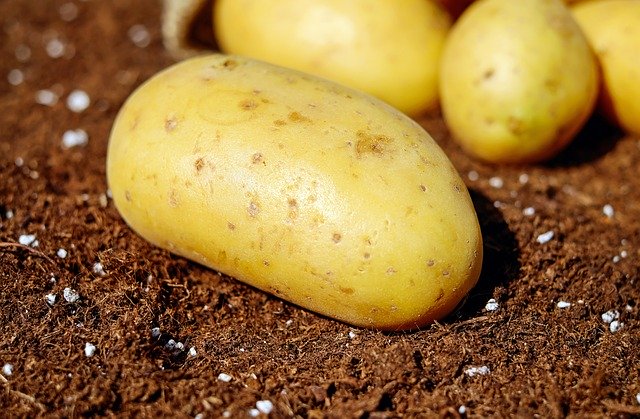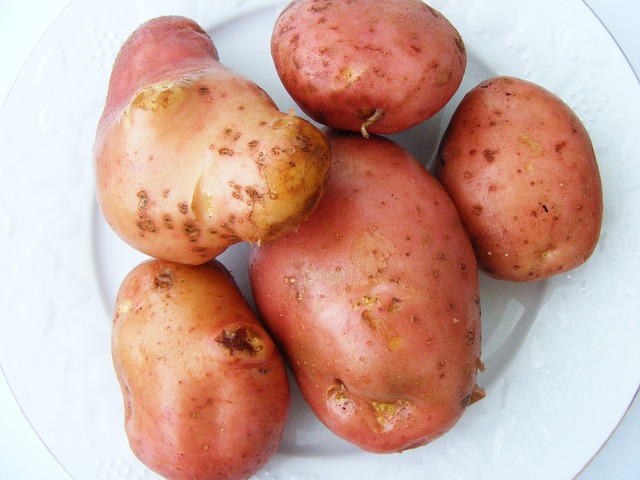What is your favorite Thanksgiving side dish? For many of us, it has to be mashed potatoes. There are more and more potato varieties in our store that I thought it would be a good time to write a Cooking Tip about potatoes. Afterall, potatoes are the most consumed vegetable in the US and, worldwide it is the fourth largest food crop.
According to Potatoes USA, potatoes were first cultivated around 8,000 BC to 5,000 BC by the Inca Indians in Peru. In the 1500s, Spanish Conquistadors conquered Peru, discovered the flavors of the potato, and took them to Europe. According to the same source, “potatoes arrived in the Colonies in 1621 when the Governor of Bermuda, Nathaniel Butler, sent two large cedar chests containing potatoes and other vegetables to Governor Francis Wyatt of Virginia at Jamestown.”
There are at least 200 varieties of potatoes although all of these can be put into the following categories: russet, yellow, red, white, blue/purple, fingerling and petite.
Another way to categorize is by texture – waxy or floury. Floury potatoes have more starch concentrated in the cells. These cells swell and separate when cooked resulting in a dry, fluffy texture. Waxy potatoes have cells that tend to stick together when cooked giving them a more dense and moist texture. Because of this difference, certain types are better suited to some uses than others. Others are in-between waxy and floury and tend to be more all-purpose. Let’s discuss these different types.

Russet – these potatoes are medium- to large-sized, oblong in shape and brown in color with whitish flesh. They are said to have a mild earthy flavor with a medium sugar content. They are a floury potato making them ideal for baking and frying resulting in a crispy exterior and a lighter, fluffy interior. They make wonderful mashed potatoes since light and fluffy is what we want in that dish. Particular varieties include Burbank, Norkotah, Ranger, Goldrush and Centennial.

Yellow – these can be very small to fairly large in size. They can be either oblong or round in shape. The skin is lighter in color in varying shades of yellow. Sugar content is medium and they are slightly waxy. When cooked, they produce a very creamy texture with a slightly sweet and buttery flavor. Great uses include baking, roasting or mashing. Names you may see include Yukon Gold, Yellow Finn, Agata, Santina and Bintje.

Red – these potatoes are usually small to medium with a rounded to slightly oblong shape. They have smooth, red skin and white flesh. This is a waxy potato with a slightly sweet flavor and a medium sugar content. The waxy texture allows the potato to stay firm throughout the cooking process. This, along with the attractive red color, means that they are great in salads, soups and stews. As a side dish, they are better boiled or roasted but can be mashed. Varieties include Chieftain, Norland, Red La Soda, Pontiac and Ruby.

White – these are small to medium in size with a round to long shape, very delicate white or tan skin and a white flesh. They have a medium starch content with a low sugar content. They can be used in a variety of ways including mashing, grilling or in salads. Names include White Rose, Cascade, Superior, Kennebec and Cobbler.

Purple/Blue – these potatoes are on the smaller to medium size with an oblong shape. The smaller oblong ones are called fingerlings. Their skins are a very pretty purple or blue with flesh that can range from white to pink to purple with shades in-between. The flavor is called earthy or nutty with a low sugar content. The flesh is moist but firm resulting in a potato that holds it shape, making it great in salads while adding a delightful color. To preserve this pretty color, they are best prepared in the microwave although you can also steam or bake them. Varieties are Purple Peruvian, Purple Majesty and Adirondack Blue.

Fingerlings – as the name suggests, these potatoes are finger-shaped. The skin color varies: red, orange, purple or white. The flesh also ranges from red to purple to yellow or white. They will often have colored veins throughout the flesh. Texture is firm and waxy. Flavor is buttery and nutty. Sugar content is medium. Pan-frying and roasting are great preparation techniques for these potatoes but they can also make an interesting potato salad. They are various varieties but they will usually just be called “Fingerlings” at the store.
Petite – these potatoes are named due to their size. The color of the skin and flesh will reflect the larger-sized varieties as will the shape, texture and sugar content. Flavor is said to be concentrated in the small size. They are great in salads and make nice roast potatoes.
Proper storage is important for the longevity of the potatoes as they continue to metabolize after harvest. Store them in a place where the temperature is about 45°-50° F and the humidity is high. Do not refrigerate. Minimize exposure to light and try to keep them in a well-ventilated place.
I started this Cooking Tip by mentioning mashed potatoes. Let me end by helping you make the perfect dish of mashed potatoes. First, start by choosing the right potato. Classically, this is the Russet but Golden Yukons go a great job, too. Scrub the potatoes. You can peel either before or after cooking them. There are those who feel that cooking them with the skin on leads to better flavor. Some even advocate not peeling at all because they like the flavor/texture of the skins in the final dish. I’m sure we have all been told that most of the nutrients are in the skin. According to the Idaho Potato Commission, the skin does contain about half of the fiber in a potato but more than half of the nutrients are in the flesh. If you score the skin around the middle of the potato, you can just pinch off the skin after cooking. Here’s a video on how to do that.
Put your potatoes (peeled or not, cubed or not) in a pot and cover with cold water. This way they cook more evenly. If you drop them in boiling water, the outside can cook before the interior. Make sure you add salt to the water so that it will penetrate the potato and add flavor that you really cannot get by just salting afterwards. Simmer for 20-30 minutes, until tender. Drain and return to the pot. Put the pot back over low heat to dry the potatoes. Now, mash the potatoes. I prefer using a ricer but if you wish a more rustic dish, use a hand masher. Mixers and food processors can be used but are not recommended as they often lead to gummy results.
I always add a bit of butter to my mashed potatoes. I soften or melt it first so it mixes in easily and I do not over-mix them. Many people add warm dairy (so it doesn’t cool the potatoes) such as milk or cream but for every-day mashed potatoes, I save some of the cooking water and use that to thin out my potatoes. It not only makes them creamy but also adds salt. So, be sure to taste before adding any additional salt. Other additions are up to you – parmesan cheese, herbs, garlic – whatever your heart desires.
Happy Thanksgiving. I am very thankful for all of you and that you take the time to read about my favorite topic – Food! Please let me know if there is anything specific you wish I would discuss.